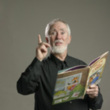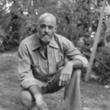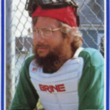Wonderful words: poems about reading, writing, speaking, and listening
Description
More Details
Similar Titles From NoveList
Published Reviews
Booklist Review
Gr. 3-6. Barbour's bright, rhythmic double-page-spread paintings are gorgeous, packed with images in vivid color and collage, but they nearly overwhelm the 15 short poems in this picture-book anthology about the joy of language. The poems have a lot to say, and they do so with lyricism and fun. David McCord's How to Say a Long Hard Word and Pat Mora's Words Free as Confetti show and tell how sound is part of sense.arlauskin talks about writing in Finding a Poem (Dig deep in you.eep everything you find ). Tom Robert Shields celebrates reading (I am the book / You are needing ). The collection will work best if an adult reads the poems aloud, giving listeners an opportunity to imagine all the places the words may take them; then children can look at the pictures and see the great connections Barbour has made. --Hazel Rochman Copyright 2004 Booklist
Publisher's Weekly Review
The third book in a series (begun with Marvelous Math: A Book of Poems, also illustrated by Barbour), this picture book collection is a linguistic pleasure. Works by Emily Dickinson, Eve Merriam and Karla Kuskin rub shoulders with poems by Nikki Grimes, David McCord and Hopkins himself. Particularly vivid is Alice Schertle's "Writing Past Midnight" in which the speaker pictures herself writing a poem about a barn and "the sound/ of sheep snoring softly/ blends with the hum of computers/ .../ spiderwebs anchor the edge of my desk to the floor/ a small gray verse runs squeaking down one of the rafters." Unfortunately, Barbour's watercolors, while artistically interesting, sometimes distance readers from the poems. With a few exceptions, such as the stunningly simple illustration for Grimes's "The Dream," the paintings can overwhelm the text, their shapes and figures appearing to compete with rather than complement the richly metaphorical poems. Although the human figures bear varying and multicultural skin tones and costumes, they often share a single expression on their stylized faces. For example, illustrating Carl Sandburg's "Primer Lesson," a crying boy's face is sprinkled with tears, but is otherwise almost identical to the faces of those who taunt him. Nonetheless, Hopkins's selection of poems about words will delight both teachers and children who want to think about the power and satisfaction words and books can bring. Ages 6-11. (Mar.) (c) Copyright PWxyz, LLC. All rights reserved
School Library Journal Review
Gr 1-5-This colorfully illustrated compilation presents 15 poems that show the power of words. The authors include Eve Merriam, Pat Mora, David McCord, Nikki Grimes, and Carl Sandburg. All of the selections are excellent, and provide examples of different types of poetry. The gouache illustrations are unusual, combining folk art with more abstract images. The colors are bold and bright, and used in unique and unexpected ways (e.g., skin is blue, palm trees are pink). The simple page designs nicely incorporate the text into each picture. The paintings reflect the content and messages of the poems they accompany, and will enhance their meaning. With some adult encouragement, this book would be appealing to most children, and could be used for poetry lessons.-Corrina Austin, Locke's Public School, St. Thomas, Ontario, Canada (c) Copyright 2010. Library Journals LLC, a wholly owned subsidiary of Media Source, Inc. No redistribution permitted.
Horn Book Review
Fifteen poems about words, one per page or double-page spread, are gathered in this picture book anthology featuring the work of poets from Emily Dickinson to Nikki Grimes to Carl Sandburg. The book's overall tone is serious and reverential, with just a few lighthearted poems relieving the mood. Despite the generous layout, the poems tend to be overwhelmed by the insistent gouache art. (c) Copyright 2010. The Horn Book, Inc., a wholly owned subsidiary of Media Source, Inc. No redistribution permitted. All rights reserved.
Kirkus Book Review
Fifteen poets, from Emily Dickinson to Karla Kuskin, celebrate the pleasures of communicating, while Barbour underscores those pleasures with dazzling, sometimes kaleidoscopic scenes of open books and stylized, often unusually colored human or animal figures. Hopkins has gathered a mix of new poems and reprints: Eve Merriam offers a "Metaphor": "Morning is / a new sheet of paper / "; Pat Mora has a tumble of "Words Free As Confetti"; the McKissacks urge children to "Share The Adventure" of reading; Kuskin of "Finding a Poem"; and Ann Whitford Paul of being a "Word Builder." Alice Schertle contributes a gem about the surreal effects of "Writing Past Midnight," and Richard Armour's disquisition on "The Period" provides an apt close. Like Eloise Greenfield's similarly themed In the Land of Words (2003), this will draw plenty of readers and listeners with its bright colors, and bright words. (Poetry. 7-12) Copyright ©Kirkus Reviews, used with permission.
Booklist Reviews
Gr. 3-6. Barbour's bright, rhythmic double-page-spread paintings are gorgeous, packed with images in vivid color and collage, but they nearly overwhelm the 15 short poems in this picture-book anthology about the joy of language. The poems have a lot to say, and they do so with lyricism and fun. David McCord's "How to Say a Long Hard Word" and Pat Mora's "Words Free as Confetti" show and tell how sound is part of sense. Karla Kuskin talks about writing in "Finding a Poem" ("Dig deep in you. Keep everything you find"). Tom Robert Shields celebrates reading ("I am the book / You are needing"). The collection will work best if an adult reads the poems aloud, giving listeners an opportunity to imagine all the places the words may take them; then children can look at the pictures and see the great connections Barbour has made. ((Reviewed February 1, 2004)) Copyright 2004 Booklist Reviews.
Publishers Weekly Reviews
The third book in a series (begun with Marvelous Math: A Book of Poems, also illustrated by Barbour), this picture book collection is a linguistic pleasure. Works by Emily Dickinson, Eve Merriam and Karla Kuskin rub shoulders with poems by Nikki Grimes, David McCord and Hopkins himself. Particularly vivid is Alice Schertle's "Writing Past Midnight" in which the speaker pictures herself writing a poem about a barn and "the sound/ of sheep snoring softly/ blends with the hum of computers/ .../ spiderwebs anchor the edge of my desk to the floor/ a small gray verse runs squeaking down one of the rafters." Unfortunately, Barbour's watercolors, while artistically interesting, sometimes distance readers from the poems. With a few exceptions, such as the stunningly simple illustration for Grimes's "The Dream," the paintings can overwhelm the text, their shapes and figures appearing to compete with rather than complement the richly metaphorical poems. Although the human figures bear varying and multicultural skin tones and costumes, they often share a single expression on their stylized faces. For example, illustrating Carl Sandburg's "Primer Lesson," a crying boy's face is sprinkled with tears, but is otherwise almost identical to the faces of those who taunt him. Nonetheless, Hopkins's selection of poems about words will delight both teachers and children who want to think about the power and satisfaction words and books can bring. Ages 6-11. (Mar.) Copyright 2004 Reed Business Information.
School Library Journal Reviews
Gr 1-5-This colorfully illustrated compilation presents 15 poems that show the power of words. The authors include Eve Merriam, Pat Mora, David McCord, Nikki Grimes, and Carl Sandburg. All of the selections are excellent, and provide examples of different types of poetry. The gouache illustrations are unusual, combining folk art with more abstract images. The colors are bold and bright, and used in unique and unexpected ways (e.g., skin is blue, palm trees are pink). The simple page designs nicely incorporate the text into each picture. The paintings reflect the content and messages of the poems they accompany, and will enhance their meaning. With some adult encouragement, this book would be appealing to most children, and could be used for poetry lessons.-Corrina Austin, Locke's Public School, St. Thomas, Ontario, Canada Copyright 2004 Reed Business Information.






























